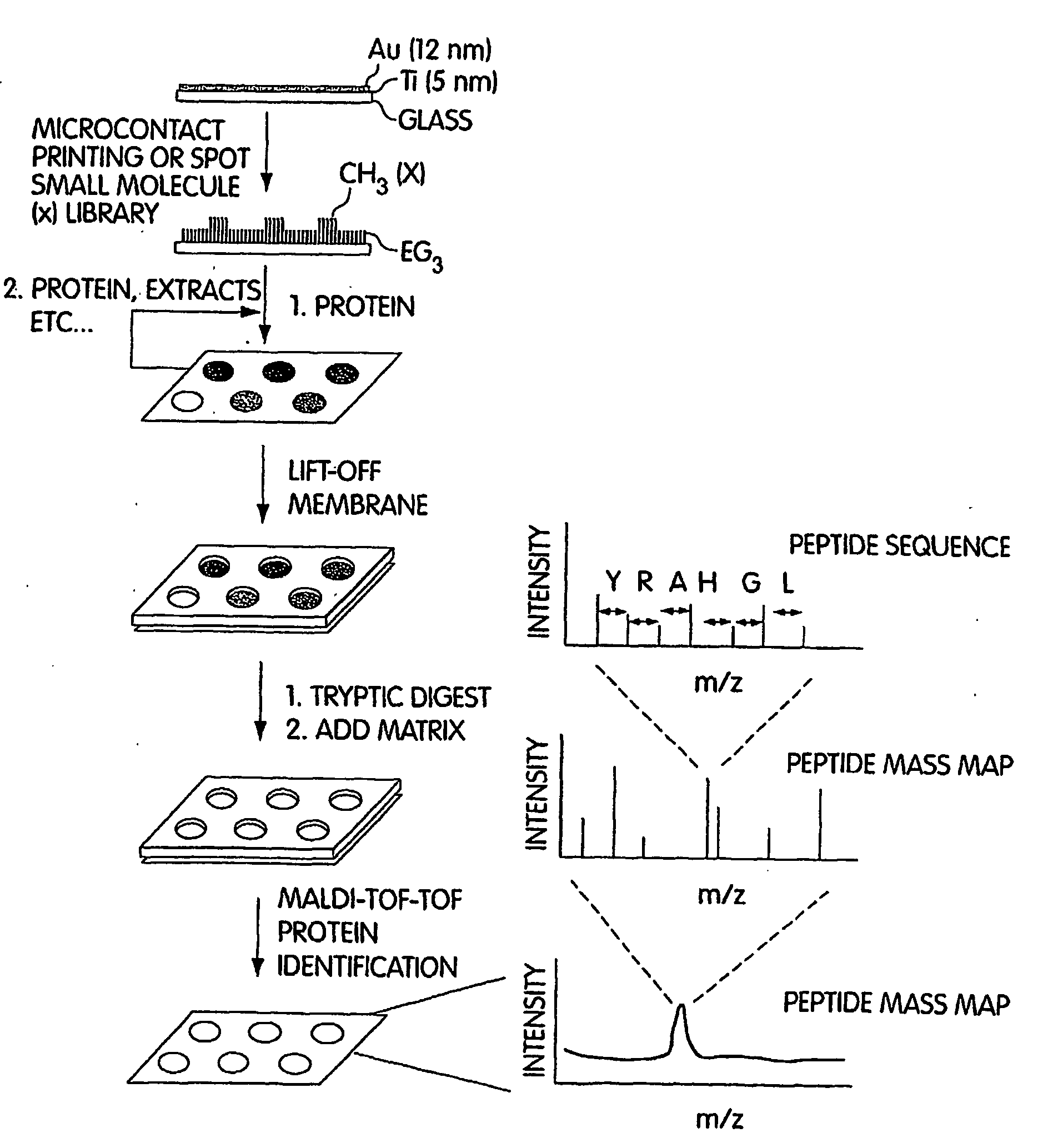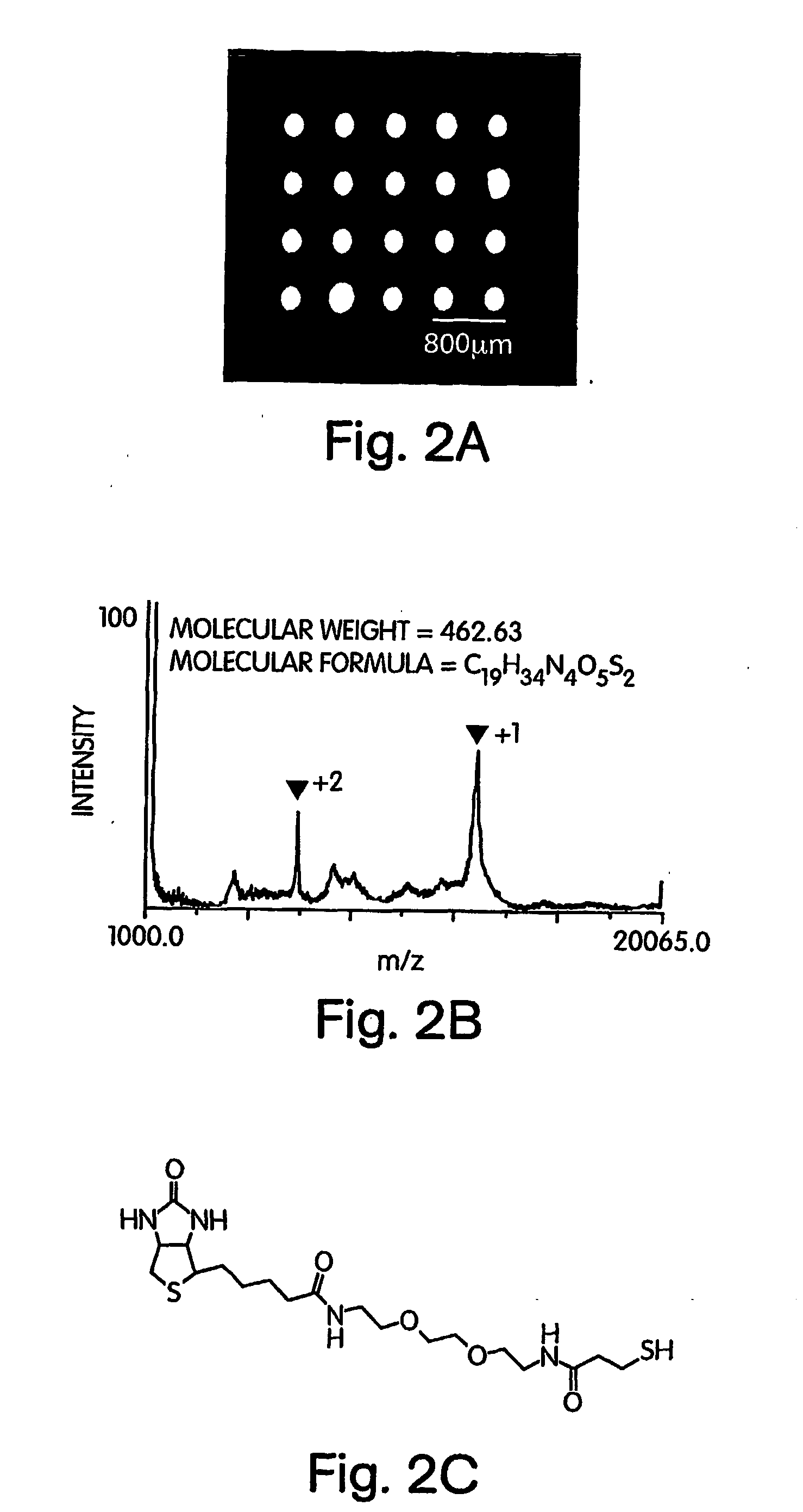Determination of Proteins and/or Other Molecules Using Mass Spectroscopy
a protein and mass spectrometry technology, applied in the field of protein and/or small molecule detection on self-assembled monolayers, can solve the problems of protein microarrays being unable to systematically identify proteins within complexes of whole cell lysates, protein interactions may change or alter the nature of the protein interactions being studied,
- Summary
- Abstract
- Description
- Claims
- Application Information
AI Technical Summary
Benefits of technology
Problems solved by technology
Method used
Image
Examples
example 1
[0058] In this example, self-assembled monolayers were prepared on gold-coated glass slides and used to make spatially addressable protein and small molecule arrays. This example combines self-assembled monolayers on gold surfaces and MALDI tandem MS capabilities. This combination also allowed the identification of novel protein-protein and protein-small molecule interactions as described below. The arrays were incubated with cell lysates in order to capture binding partners to the proteins or small molecules. Lysates were prepared by homogenization in modified PBS buffer, 0.1% Triton X-100, with 1× protease inhibitor cocktail for tissue culture lysate (Sigma-Aldrich) and 400 micromolar Na3VO4, 20 mM NaF, and 2 mM sodium molybdate. Cell debris was removed by centrifugation.
[0059] An in situ digestion using various enzymes was performed on the arrays in some cases. For in situ digestion, N-octylglucopyranoside was added as a detergent to the array at a concentration of 10 mM. The ar...
example 2
[0062] This example describes the use of MALDI tandem TOF mass spectrometry for the identification of protein-protein interactions using a microarray. This method can also be termed “SPaM” for Self-assembled monolayers, in situ Proteolytic digestion and MALDI mass spectrometry to identify proteins on microarrays. This example also illustrates use of certain methods for the detection of proteins that interact with small molecules.
[0063] The identification of binding proteins was achieved by using an in situ microarray proteolytic digest along with MALDI tandem MS. The in situ digest produced peptides from binding proteins that were sequenced with high sensitivities, which allowed the unambiguous identification of protein binding partners. Slides were prepared using techniques similar to those described in Example 1. Surface treatments were used to reduce nonspecific surface interactions, as mass spectrometry is highly sensitive and nonspecific interactions tend to produce high backg...
example 3
[0074] In cases where peptides were utilized for the analysis in order to provide unambiguous protein identification, the problem of on-target digestion without any sample carry-over from one spot to the other was solved in this example as follows. The digest was performed in situ on the array in a humidity chamber without any prior reduction and alkylation. Subsequently, a MALDI matrix suitable for peptide analysis such as alpha-cyano-4-hydroxycinnamic acid was added to the digest array and the solution was evaporated under reduced pressure. The gold substrate with the array was then placed on a target that was specifically machined so as to accommodate the chip while maintaining the voltage on the surface of the chip. A gold coated array was useful for this type of analysis as the metal layer was conductive, thereby facilitating sensitive MALDI without unduly compromising accuracy and resolution.
[0075] In order to demonstrate this strategy with a small molecule-protein interactio...
PUM
| Property | Measurement | Unit |
|---|---|---|
| molecular weight | aaaaa | aaaaa |
| molecular weight | aaaaa | aaaaa |
| atomic mass unit | aaaaa | aaaaa |
Abstract
Description
Claims
Application Information
 Login to View More
Login to View More - R&D
- Intellectual Property
- Life Sciences
- Materials
- Tech Scout
- Unparalleled Data Quality
- Higher Quality Content
- 60% Fewer Hallucinations
Browse by: Latest US Patents, China's latest patents, Technical Efficacy Thesaurus, Application Domain, Technology Topic, Popular Technical Reports.
© 2025 PatSnap. All rights reserved.Legal|Privacy policy|Modern Slavery Act Transparency Statement|Sitemap|About US| Contact US: help@patsnap.com



